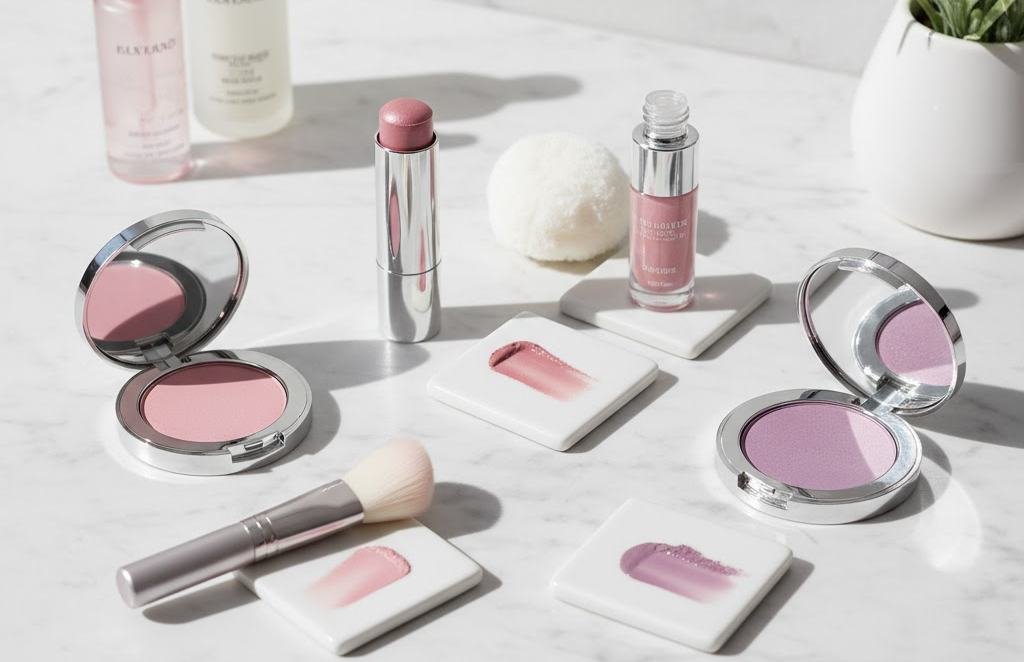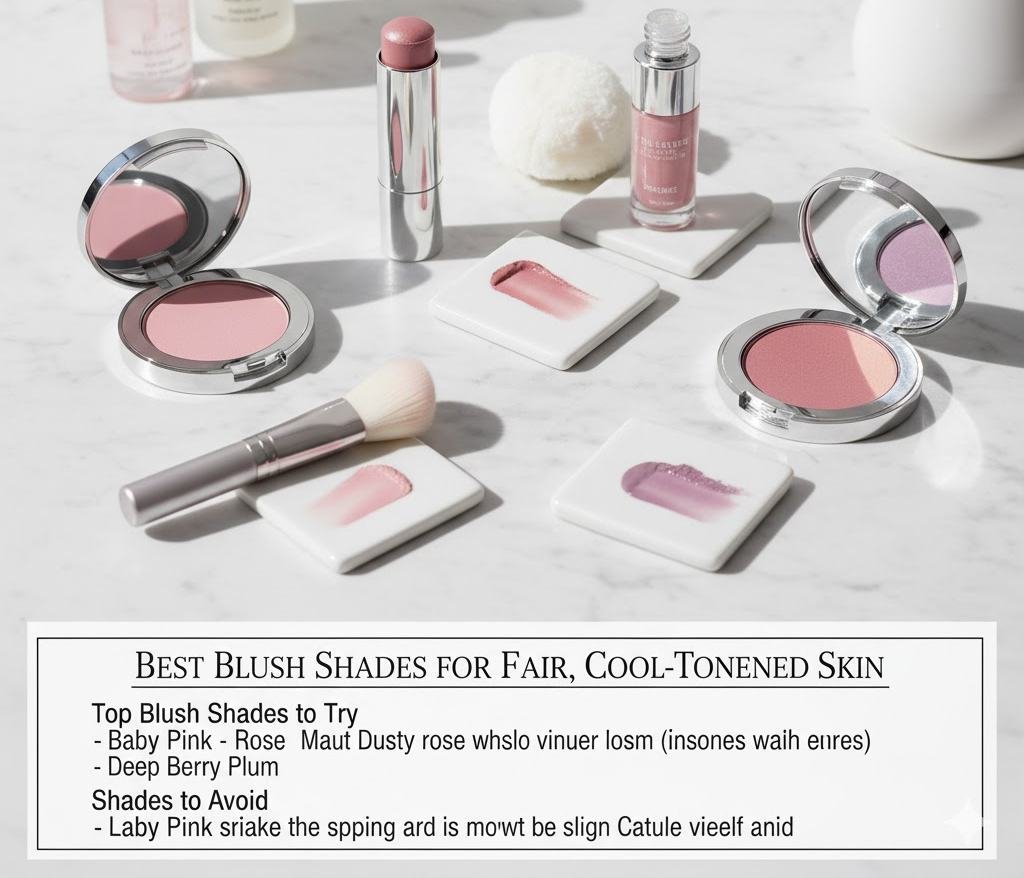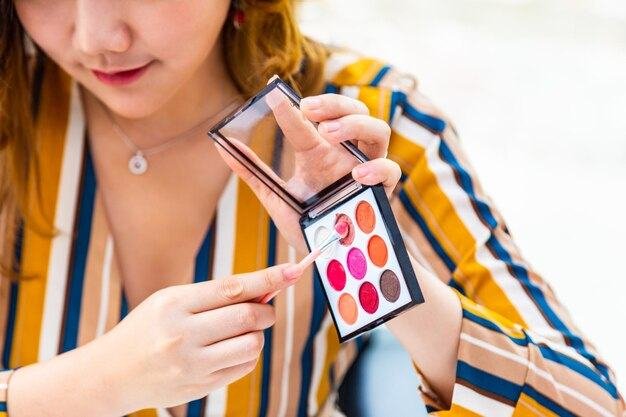Best Blush for Fair Skin with Cool Undertones

Choosing the right blush can completely change how your face looks — it adds warmth, liveliness, and dimension to your features. But if you have fair skin with cool undertones, not every shade will flatter you. The goal is to find colors that bring out your natural pink or rosy tint without making your face look red or chalky.
This article explains in simple words how to find blush shades that look beautiful on fair, cool-toned skin. You’ll learn which colors suit you best, how to apply them correctly, and what finishes to pick for a natural glow.
Understanding Fair Skin and Cool Undertones
When choosing any makeup — especially blush — knowing your skin tone and undertone helps you get a perfect match.
What Fair Skin Means
Fair skin is very light and delicate. It usually:
- Burns or freckles easily in the sun.
- Looks more pink than golden.
- Shows redness faster than deeper skin tones.
Because fair skin reflects light strongly, bright or dark blushes can sometimes look harsh. Lighter, more fabulous shades blend in better and create a more seamless finish.
What Cool Undertones Are
If your skin has cool undertones, it means there are blue, pink, or rosy hues beneath the surface. You might notice:
- Veins on your wrist appear blue or purple.
- Silver jewelry tends to look more flattering than gold.
- Pure white clothes look better than ivory or Cream.
People with cool undertones look best in shades that also lean cool — think pinks, mauves, berries, and soft plums. Warm peach or orange-based blushes, on the other hand, can make the skin look slightly orange or dull.
Best Blush Shades for Fair, Cool-Toned Skin

When you have a cool undertone, choosing the right blush color makes your skin look naturally flushed rather than painted. Below are blush colors that look soft, natural, and complementary on fair, cool-toned skin.
Top Blush Shades to Try
| Blush Shade | Why It Works | How to Use It |
|---|---|---|
| Soft Pink | Mimics a natural flush for fair skin and matches cool undertones perfectly. | Sweep lightly on the apples of your cheeks for a “just outside in the cold” glow. |
| Rose | Balanced, romantic pink with cool undertones that flatters light skin tones. | Blend gently upward for a lifted effect. |
| Mauve | Has hints of purple and pink that suit blue-based skin tones. | Great for subtle daytime looks or soft office makeup. |
| Berry | Adds brightness without being orange or coral; perfect for winter months. | Apply sparingly and blend well for a healthy pop of color. |
| Light Plum | Brings depth while still looking cool-toned and elegant. | Best for evening wear or soft glam looks. |
Shades to Avoid
Some blush colors may overpower or clash with cool-toned fair skin.
- Peach or coral: Too warm; can make your skin look orange.
- Brick red: Overly strong and harsh against pale complexions.
- Brown or tan blush: Makes fair skin look muddy or dull.
- Golden or warm pinks: Can highlight redness in cool skin.
Instead, stick to shades with blue or lavender undertones. They will balance the natural rosiness of your skin.
Picking the Right Blush Formula
Blushes come in different textures — powder, Cream, and liquid. Each has its own finish and feel on the skin. The right formula depends on your skin type and the look you prefer.
Powder Blush
- Best for: Normal to oily skin.
- Why it works: Easy to control and blend, especially for beginners.
- Tip: Choose finely milled powders that don’t look chalky on fair skin.
Cream Blush
- Best for: Dry or mature skin.
- Why it works: Adds a fresh, natural-looking glow.
- Tip: Use your fingers or a sponge for seamless blending.
Liquid or Gel Blush
- Best for: A dewy, modern finish.
- Why it works: Creates a skin-like flush that lasts longer.
- Tip: Start with a tiny amount — liquid formulas are very pigmented.
| Skin Type | Ideal Blush Formula | Example Use |
|---|---|---|
| Oily | Powder blush | Matte finish that stays in place |
| Dry | Cream blush | Moisturizing texture adds glow |
| Combination | Gel or hybrid formula | Smooths skin without heaviness |
| Mature | Cream or satin blush | Avoids accentuating fine lines |
Right Blush Finish for Cool Fair Skin
Different finishes can change how your blush looks on the skin.
Matte Finish
- Gives a soft, airbrushed effect.
- Perfect for oily skin or for a clean, professional look.
Satin Finish
- Slightly luminous but not shiny.
- Looks natural in daylight — ideal for everyday wear.
Dewy or Shimmer Finish
- Adds radiance and a youthful glow.
- Best for evening or when you want your skin to look fresh and hydrated.
For fair, cool-toned skin, avoid blushes with too much gold or orange shimmer — these can clash with your undertones. Instead, go for silvery or icy-pink shimmer if you want extra glow.
Application Tips for a Natural Look
Even the best blush shade can look wrong if it’s misapplied. Fair skin especially requires a light hand and careful blending.
Step-by-Step Blush Application
- Prep your skin: Apply foundation, then lightly set it with powder. This helps your blush blend evenly.
- Smile slightly: Find the apples of your cheeks — this is where your blush should start.
- Apply with a light touch: Use a fluffy brush for powder or your fingertips for cream formulas.
- Blend upward: Move the color toward your temples to lift your face.
- Build slowly: Start with a small amount of product and add more only if needed.
- Soften harsh edges: Use a clean brush or sponge to blur the edges for a seamless look.
Extra Tips
- For round faces, apply blush slightly higher on the cheekbones to elongate the face.
- For oval faces, focus blush directly on the apples of the cheeks.
- For square faces, soften angles by sweeping blush diagonally toward the temples.
| Face Shape | Blush Placement | Result |
|---|---|---|
| Round | Slightly above apples | Adds definition |
| Oval | Apples of cheeks | Balanced, natural flush |
| Square | Diagonal along cheekbones | Softens structure |
| Heart | Just below cheekbones | Balances wider forehead |
Mistakes to Avoid
| Common Mistake | Why It Happens | How to Fix It |
|---|---|---|
| Applying too much product | Fair skin shows color quickly | Start small and build gradually |
| Using the wrong undertone | Warm blushes clash with cool skin | Stick to pinks, roses, and mauves |
| Not blending properly | Harsh lines look unnatural | Use a soft brush or sponge to blend |
| Choosing too dark a shade | Overpowers light skin | Stay within soft pink or light berry tones |
| Skipping highlighter or bronzer | Face can look flat | Add subtle glow to bring dimension |
Expert Advice from Makeup Artists

Professional makeup artists agree that cool-toned blush shades look best on fair skin because they match the natural flush tone.
- Charlotte Tilbury recommends pale pink and rosy blushes to create a youthful glow without overpowering fair skin.
- Lisa Eldridge, celebrity makeup artist, suggests that fair, cool-toned skin looks healthiest with “blue-based pinks or mauves” because they mimic natural blood tones.
- Bobbi Brown’s team notes that cool-toned blushes, especially in sheer formulas, give fair skin a soft, candle-lit radiance.
Experts also advise against applying blush too close to the nose, as this can exaggerate redness — something fair, cool-toned skin often struggles with naturally.
How to Match Blush with Lip and Eye Makeup
Blush doesn’t work alone — it ties your whole look together.
For Everyday Natural Looks
- Pair soft pink blush with rose or nude-pink lipstick.
- Keep eyes light with taupe or soft brown shadow and brown mascara.
For Glam or Nighttime Looks
- Combine berry blush with plum or mauve lipstick.
- Add cool-toned eyeshadow (silver, lavender, or soft smoky grey) for balance.
For No-Makeup Makeup Days
- Use cream blush in a neutral rose shade on both cheeks and lips.
- Skip powder and let your skin’s natural texture show through.
Seasonal Blush Shades for Fair, Cool-Toned Skin
Your blush shade can change with the seasons, depending on light and temperature.
| Season | Best Shades | Why It Works |
|---|---|---|
| Winter | Cool rose, berry, plum | Matches cooler lighting and adds life to pale skin |
| Spring | Soft pink, light mauve | Fresh, youthful, and bright under daylight |
| Summer | Sheer rose, baby pink | Light and breathable for warm weather |
| Autumn | Dusty rose, muted mauve | Adds warmth without turning orange |
Product Recommendations
Here are blushes that makeup artists and real users love for fair, cool-toned skin:
| Product | Type | Shade Recommendation | Why It’s Great |
|---|---|---|---|
| NARS Blush in “Sex Appeal” | Powder | Soft peachy-pink (still cool-based) | Subtle color for pale skin |
| Glossier Cloud Paint in “Puff” | Gel-cream | Cool pink | Buildable and natural finish |
| Milani Baked Blush in “Dolce Pink” | Powder | Light pink with slight sheen | Affordable and luminous |
| Rare Beauty Soft Pinch Blush in “Happy” | Liquid | Bright cool pink | A little goes a long way |
| Clinique Cheek Pop in “Pansy Pop” | Powder | Cool lavender-pink | Perfect for porcelain skin |
| MAC Glow Play Blush in “So Natural” | Cream | Rosy nude | Smooth, blendable texture |
Caring for Your Skin and Blush Longevity
Even the best blush won’t last without proper skin prep.
- Moisturize well: Fair, cool skin can get dry, which makes blush patchy.
- Use primer: Helps blush adhere and prevents fading.
- Set Cream or liquid blushes: Lightly dust translucent powder to lock them in place.
- Blot gently, not wipe: If you need to remove shine during the day, pat with blotting paper to avoid lifting the blush.
Final Thoughts
Blush is more than just color — it’s about bringing warmth and life back to your face. For fair skin with cool undertones, the best shades are soft pinks, roses, mauves, and berries. They blend naturally with your skin’s undertone and enhance your natural glow.
Always start light, blend well, and choose formulas that suit your skin type. Whether you prefer a powder, Cream, or liquid blush, the right color can make you look effortlessly fresh and confident.
Your perfect blush doesn’t need to be complicated — it just needs to feel like you.
